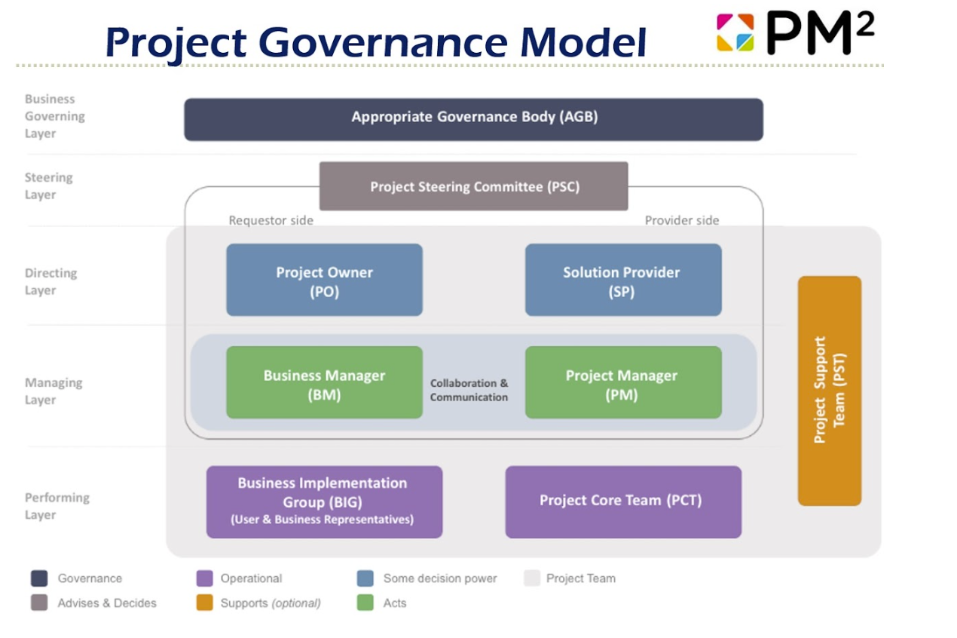PM² Project Management Methodology
PM² Project Management Methodology
PM² (pronounced “P-M squared”) is the official Project Management Methodology of the European Union Institutions. It is based on operational experience from projects run within the European Institutions, but also incorporates elements from a wide range of globally accepted project management best practices, standards and methodologies such as PMBoK Guide and PRINCE2®. PM² is a light, easy-to-implement methodology, and it provides open and free access to:
- a Project Management Methodology Guide
- Project Management Templates
- and Training Material ((opens in a new window)slides and (opens in a new window)e-learning).
PM² is being adopted as the recommended Project Management Methodology across UCD, so that, at an enterprise level, we have a defined, consistent way of working on projects.
- For an overview of PM², see the PM² Project Management Methodology - Quick Guide for UCD Staff.
A one-day 'PM² Essentials' course on the PM² Project Management Methodology is offered as part of the UCD HR People and Organisation Development course catalogue offerings. In addition, UCD Agile and the IT PMO provide support & training.
Project Governance Model (roles and responsibilities)
Requestor Side
Project Owner (PO)
The unit being the main beneficiary of the project usually nominates a person as the owner of the project, namely the Project Owner (PO). The Project Owner (PO) is the client of the project, who chairs the Project Steering Committee (PSC) and is the key-decision maker. As the key Directing Layer role from the requestor side, the Project Owner (PO) is accountable for the overall project’s success, and later becomes the owner of the project’s outputs (product or service), or ensures ownership of the project’s outputs.
Business Manager (BM)
The Business Manager (BM) represents the Project Owner (PO) on a daily basis and collaborates closely with the Project manager (PM). The Business Manager (BM) manages the client-side activities and roles (e.g. user and business representatives), assuring that the required business resources are made available. The Business Manager (BM) ensures that the project’s deliverables fulfil the business and user needs, and leads organisational change management activities for the implementation of the business changes (e.g. user training).
-------------------------------------------------------------------------------------------------------------------------------------------------------------------
Provider Side
Solution Provider (SP)
The unit that will execute the project and will be accountable for the deliverables requested by the PO, will nominate a person to act as the Solution Provider (SP). As the key Directing Layer role from the provider side, the Solution Provider (SP) appoints the Project Manager (PM) and represents the interests of those who design, manage and implement (or outsource) the project’s deliverables. The Solution Provider (SP) is a UCD employee and for outsourced activities, the Solution Provider (SP) becomes accountable for the contractor's performance.
Project Manager (PM)
The Project Manager (PM) oversees the project on a daily basis and is responsible for delivering high-quality results within the identified objectives and constraints, ensuring the effective use of the allocated resources. More widely, the Project Manager’s (PM) responsibility also includes risk and issue management, project communication and stakeholder management.
For more information on the PM² Project Governance Model, you can refer to the PM² Project Management Methodology Guide (pages 23 - 26).

Project Outputs, Outcomes and Benefits
What is a Project?
A project is a temporary organisational structure which is set up to create a unique product or service (output) within certain constraints (such as time, cost, and quality).
Why do we do Projects?
PROJECT >> OUTPUTS >> OUTCOMES >> BENEFITS
Projects deliver outputs (deliverables) that deliver a change. These changes generate outcomes for the beneficiaries or users. In the long term these outcomes produce benefits or impact. These benefits realise or support the organisation's strategy.
OUTPUTS / DELIVERABLES
The project manager should identify what is considered as the scope of the project, i.e., the list of deliverables or outputs that the project will deliver and which form the solution which addresses the current situation (problem, need or opportunity).
Think of outputs / deliverables as products or services produced as a result of the project. An output / deliverable could be an automated report, a migrated database, a document, a server, a new policy or regulation, a conference, a training, a campaign, etc.
Note that the standard project management deliverables (e.g. the Project Management Artefacts) should not be considered in this section.
Along with newly created outputs / deliverables, consider … what currently exists that will be updated due to this solution?
OUTCOMES
Think of outcomes as the result of the change that the proposed project will implement in the organisation – the future or desired state. What value will it deliver to the University? E.g. an outcome may be increased research impact, or increased revenue.
BENEFITS
How will success be measured? It should be possible to link measurable benefits directly to the outcomes. Think of benefits as the measurable improvement resulting from the previously described expected outcomes as they are perceived as an advantage by one or more stakeholders. E.g. 10% increase in publication volume.
Note that project outcomes and benefits are often realised only after the project has closed.
Click here for more on Benefits Management.
This PM² information is from two sources:
1) The (opens in a new window)European Commission’s Centre of Excellence in Project Management (CoEPM²)
2) The PM² user group, (opens in a new window)PM² Alliance
UCD has organisational membership of the PM² Alliance, which offers all UCD staff and students:
- Discount of 20% on all certifications
- Free access to online events
- Discount on paid events
Contact (opens in a new window)UCD’s IT PMO Manager if you have queries on the PM² Alliance.
For IT PMO Queries please contact (opens in a new window)(opens in a new window)UCD's IT PMO Manager.
UCD IT Services
Computer Centre, University College Dublin, Belfield, Dublin 4, Ireland.Contact us via the UCD IT Support Hub: www.ucd.ie/ithelp